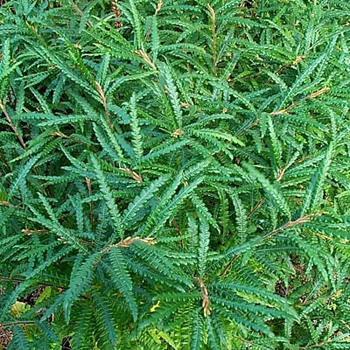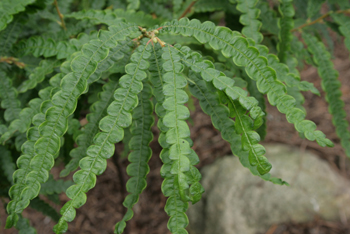Contents:
Common Names | Parts Usually Used | Plant(s) & Culture | Where Found | Medicinal Properties
Legends, Myths and Stories | Uses | Formulas or Dosages | Bibliography
Scientific Names

- Comptonia peregrina L.
- Comptonia asplenifolia
- Myricaceae
- Bayberry family
Common Names
- Fern bush
- Fern gale
- Meadow fern
- Sweet bush
Parts Usually Used
The whole herb, mainly the leaves
Back to Top

Description of Plant(s) and Culture
Sweet fern is a strongly aromatic, fernlike deciduous shrub; its slender, reddish-brown branches grow up to 5 feet high and bear alternate, short-petioled, linear-oblong leaves that are deeply pinnatifid with lobes that are broader than they are long. The leaves are soft-hairy, lance shaped; 3-6 inches long with prominent rounded teeth. Male flowers grow in cylindrical catkins, female in egg-shaped catkins that develop into clusters of brown, shining, ovoid, burrlike, nutlets.
Back to Top
Where Found
Found on dry hills from Nova Scotia to North Carolina, Georgia mountains; Ohio, Nebraska, Illinois to Minnesota, Manitoba. Grows in infertile soils near shores, but it is also a common weedy shrub of dry roadsides, gravel banks, and woodland clearings.
Back to Top
Medicinal Properties
Astringent, tonic
Back to Top
Legends, Myths and Stories
Sweet fern is not actually a fern; rather, it is a member of the Bayberry family. The flowers are not showy, and the fruits resemble small, slender cones. For the species C. peregrina, the name peregrina means “foreign”. This is a misnomer from an American perspective: although the plant was foreign to the European botanist who first named it, it is native to North America. Some references refer to sweet fern as belonging to the Wax-myrtle family, but Webster’s Dictionary clearly states it belongs to the Bayberry family.
Native Americans used the leaves in smudge fires, and lined their baskets with them when gathering highly perishable berries. In 1854, Howard wrote that the leaves make a very pleasant tea, with the addition of cream and sugar, children rarely refused it.
Back to Top
Uses
The primary use has been to relieve diarrhea. Also can be used for skin problems. Native Americans soaked the leaves in water to make a was for poison ivy irritation. Also, Native Americans used it as a beverage, as a poison, and to stop bleeding: a strong decoction was used externally for rheumatism and bruises. Folk remedy for vomiting of blood, leukorrhea, rheumatism.
Back to Top
Formulas or Dosages
Infusion: steep 1 tsp. plant in 1 cup boiling water. Take 1 to 2 cups per day, a mouthful at a time.
Tincture: a dose is 1/2 to 1 tsp.
Back to Top
Bibliography
![]() American Folk Medicine
American Folk Medicine, by Clarence Meyer, Meyerbooks, publisher, PO Box 427, Glenwood, Illinois 60425, 1973
![]() Eastern/Central Medicinal Plants
Eastern/Central Medicinal Plants, by Steven Foster and James A. Duke., Houghton Mifflin Company, 215 Park Avenue South, New York, NY 10000
![]() The Herbalist Almanac
The Herbalist Almanac, by Clarence Meyer, Meyerbooks, publisher, PO Box 427, Glenwood, Illinois 60425, copyright 1988, fifth printing, 1994
![]() The Herb Book
The Herb Book, by John Lust, Bantam Books, 666 Fifth Avenue, New York, NY. copyright 1974.
Herbal Gardening, compiled by The Robison York State Herb Garden, Cornell Plantations, Matthaei Botanical Gardens of the University of Michigan, University of California Botanical Garden, Berkeley., Pantheon Books, Knopf Publishing Group, New York, 1994, first edition
 Old Ways Rediscovered
Old Ways Rediscovered, by Clarence Meyer, Meyerbooks, publisher, PO Box 427, Glenwood, Illinois 60425, published from 1954, print 1988
![]() Webster’s New World Dictionary
Webster’s New World Dictionary, Third College Edition, Victoria Neufeldt, Editor in Chief, New World Dictionaries: A Division of Simon & Schuster, Inc., 15 Columbus Circle, New York, NY 10023
 The Rodale Herb Book: How to Use, Grow, and Buy Nature’s Miracle Plants (An Organic gardening and farming book)
The Rodale Herb Book: How to Use, Grow, and Buy Nature’s Miracle Plants (An Organic gardening and farming book), edited by William H. Hylton, Rodale Press, Inc. Emmaus, PA, 18049., 1974
